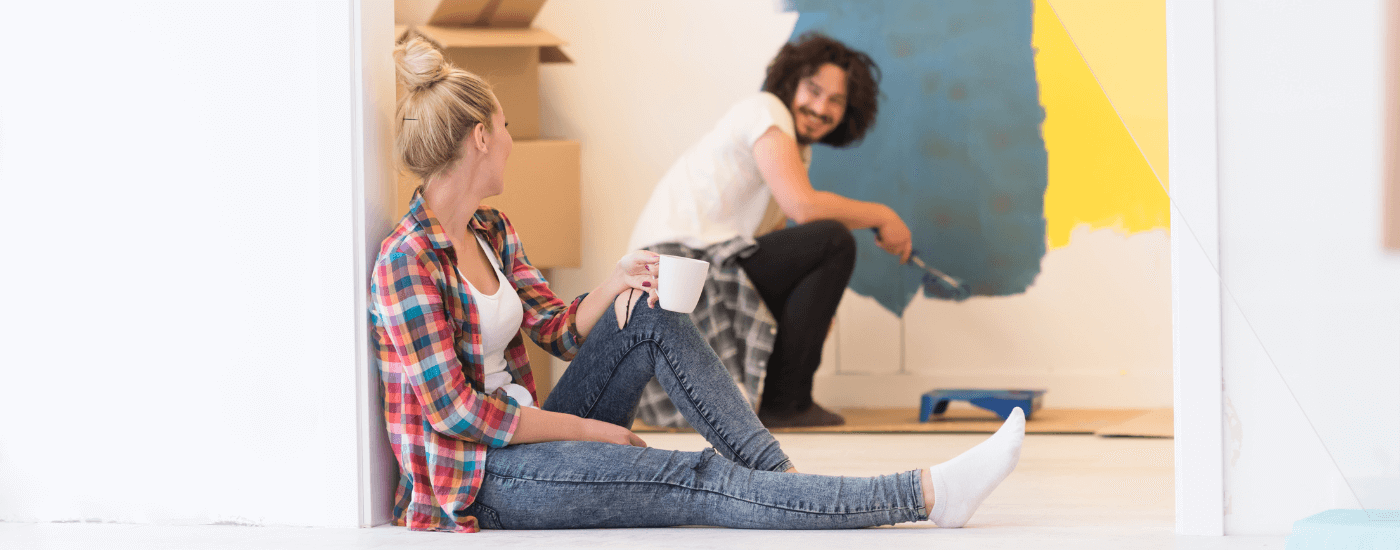Buying a home, especially as a first-time homebuyer, is thrilling. According to the Hippo 2022 Home Preparedness Report, 89% of first-time homeowners are happy they own their home — and it’s easy to see why. You get to move to a space that’s yours to decorate, use, and enjoy as you like.
However, with that privilege comes a lot of responsibility. Once your initial excitement wanes, the full weight of homeownership might start to set in. Think: the financial load, the upkeep, and the unexpected repairs. We learned in our 2023 homeowner regrets survey that nearly a third of responding homeowners regretted delaying home maintenance that year.
To crush your homeownership goals and avoid homebuyer’s remorse, it’s helpful to have a better understanding of what your first year as a homeowner will look like — from the initial move-in to the inevitable updates.
Keep reading for a month-by-month breakdown of your first year as a homeowner.
Key takeaways:
- The first year as a homeowner comes with lots of highs and lows. You’ll be dealing with everything from unpacking and budgeting to furnishing your space and handling unexpected repairs.
- As you settle into your home, it’s important to make sure everything works properly, schedule necessary repairs and updates, and plan for seasonal maintenance.
- Over three in four (76%) homeowners feel confident in their ability to handle home care; and 93% of first-time homeowners agree that they would rather take action on smaller repairs now to save on big costs later.
Month 1: Moving in
The first month moving into your new home is equal parts exciting and overwhelming. You’ll probably be exploring your new space, unpacking boxes, and spending late nights organizing your kitchen cabinets. Here’s what else you might be doing:
Doing a full walkthrough of your home
While your home is still empty, take time to inspect it for any problems. It’s critical to make sure the previous homeowner completed your requested repairs and changes, and that everything — including appliances, outlets, windows, and doors — is functioning properly.
If you notice any issues, like if the previous homeowner took the fridge they were supposed to leave for you, reach out to your real estate agent immediately. This is also a good opportunity to take note of any urgent repairs you need to make to improve your home’s safety and functionality.
Verifying that your utilities are working
Check that your internet, gas, electric, water, and heat are all turned on and working properly.
Deep cleaning your home
Taking the time now to deep clean your home makes it easier once you move everything in. If you don’t have the time or materials to do it yourself, consider hiring a professional cleaning crew.
Child or pet-proofing your home
If you have kids and pets, now's a good time to pet-proof your home. This can include pet-friendly home upgrades like dog doors, stair gates, and closing up cabinets and outlets.
Setting up your most-used spaces
You may not have your home completely decorated or furnished during the first month, and that’s completely normal. You’ll probably be focused on outfitting your most used spaces — like your kitchen, bedroom, and bathroom — with the basic necessities for daily life.
Familiarizing yourself with your space
Get to know your home’s anatomy as you settle in. Figure out where the fuse box and water valve are, take note of which room gets the best afternoon light, and explore your home’s unique quirks.
Hosting a casual housewarming party
Once you’re fully unpacked, invite a few friends or loved ones over to celebrate your new space.
Months 2-5: Getting to know your space
Once you’re unpacked, you’ll probably spend the next several months getting to know your space better. That includes using your various rooms, appliances, and fixtures every day to see how they function, developing routines, and making occasional changes — both utilitarian and aesthetic — to your space. Here’s what you can expect:
Furnishing your home
After living in your home for a while, you may be ready to furnish it. You might find yourself ordering couches and tables online, trying out new lighting systems, or swapping out rugs and wall decor.
Setting up home maintenance systems
Over half (58%) of homeowners are concerned about staying on top of regular home maintenance, but with the right systems and strategy, home maintenance can be simple. Depending on your home goals, you could designate Mondays as your deep-clean days, for example, install a sprinkler system, or hire a landscaping professional to spruce up your backyard once a month. Check out our home maintenance checklist for new homeowners to get started.
Preparing for seasonal changes
As soon as possible, look ahead to the next season and figure out how to prepare your home. Forty-three percent of homeowners are concerned about severe weather damaging their home, while 34% are concerned about climate threats leading to home damage.
To protect your home, it’s crucial to understand the seasonal hazards your home faces — and what changes to make. If hurricane season is approaching, for example, you’ll need to inspect your roof and inventory your belongings. Or if summer is on the horizon and your area is prone to wildfires, take the time to invest in wildfire-proofing your space.
Taking care of necessary repairs
A couple of months in, you’ll start to see the cracks — literally and figuratively — in your new space. You might notice a leaky faucet, uncover peeling siding, or learn (the hard way) that it’s time to replace your garbage disposal.
Sixty percent of homeowners have experienced unexpected repairs in the last year, which may be the reason 67% of homeowners proactively seek out ways to avoid repair issues around their home. That starts with handling the little things as they come up before they escalate into bigger (and more expensive) problems.
Digging into your finances
After spending a few months in your home, you’ll have a better idea of the daily expenses and costs that come with living in and maintaining it. To set yourself up for success, it’s a good idea to develop a budget and plan for making your monthly mortgage payment and building a cash cushion.
Ideally, you’ll want to start setting aside money for necessary and nice-to-have renovations, as well as emergencies and unexpected repairs. It’s also helpful to have a realistic idea of costs so you can budget accordingly for home maintenance. First-time homeowners paid an average of $3,828 on unexpected home repairs in the last year.
Meeting the neighbors and exploring your neighborhood
Amidst all the financial planning and repair scheduling you’ll be doing, carve out some time to introduce yourself to your neighbors and get to know the local community.
Months 6-9: Planning or pursuing renovations and design changes
By now, you should know how your home functions, what you like about it, and what you’d like to change (if anything). You should also have a clearer picture of your finances and home expenses. That’s why it’s a great time to move forward with renovation or design plans, whether you want to start researching contractors and getting quotes — or whether you’re ready to jump into full-on demolition.
Here’s what else you’ll probably be focusing on:
Reviewing seasonal maintenance checklists
Your first year in your new home, it’s critical to understand how to protect your property during different seasonal conditions. Start by reading a seasonal home maintenance checklist. From there, order or gather any materials you’ll need, then make plans to update or outfit your home.
Scheduling renovations
Home renovations and upgrades can take a long time, especially with ongoing supply chain issues. Two out of five (40%) homeowners say supply chain issues and shortages have kept them from doing home maintenance or improvement projects in the last few months. So it’s crucial to make moves if you feel financially and logistically prepared.
If you found a reliable contractor to renovate your bathroom, for example, get a starting date on the calendar asap (along with a clear estimate of exactly how much money the project will cost), then order any materials and fixtures you might need. Make note of any tax-deductible home improvements so that you’re prepared when tax season rolls around.
Prioritizing impactful repairs
Make a list of any urgent and necessary repairs you need to make to ensure your home’s safety or get ahead of severe weather. Then start researching solutions and costs. Nearly three out of four homeowners (72%) prefer to handle home repairs themselves to save money, but it’s smart to know your limits. Don’t be afraid to hire a professional if you don’t have the skills or resources.
Adjusting your budget
As a homeowner, it’s smart to continually revisit your budget and financial goals to make sure you’re on track. Depending on your personal financial situation and home’s costs, you may need to tighten your budget or adjust your plans for renovating or designing.
As inflation worsens, it’s particularly important to understand your spending limits. If you’re more cautious lately, you’re not alone; 61% of first-time homeowners say they’re less comfortable making big household purchases due to inflation.
Decorating
Decorating a home to be personal, comfortable, and functional takes time. You may be waiting on shipments to arrive, scouring local markets for vintage art or furniture, or spending your weekends experimenting with how to arrange and display your items.
Months 10-12: Refining your space
You’ll probably spend the last several months of the first year in your new home setting up your space for long-term enjoyment. That means investing in organization, smart systems, and comprehensive home insurance. Here’s what you might be up to:
Organizing your home
After living in your home for the better part of a year, you may want to get even more organized. You might decide to install vertical storage racks in your garage, for example, reorganize your kitchen pantry, declutter your closet, or rearrange your space for better mental health.
Streamlining home maintenance
You’ve already been maintaining your home for nearly a year, but is everything working as smoothly as you’d like? If not, now is a great opportunity to streamline your home maintenance for more efficiency and ease. Maybe you want to hire a professional cleaning crew to come over every other week, or set up automatic orders for seasonal maintenance supplies (like sandbags or air filters) so you don’t have to think about it.
Introducing smart technology
Take advantage of smart technology to improve your home’s safety and protection (and potentially save money). Thirty-eight percent of first-time homeowners currently use smart home tech devices; the top two reasons are increased security and general convenience.
Devices like water detection leaks can alert you to potential water damage before it becomes a problem, while security systems can help prevent theft. There are also a variety of smart devices — like smart candles and scent diffusers — designed to enhance your home’s ambiance and comfort.
Building a cash cushion
Work on creating an ongoing long-term cash cushion specifically for home expenses and emergencies. Over half (56%) of homeowners are concerned about having enough money to cover unexpected repairs. Things like replacing your water heater, winterizing your home, and paying your annual homeownership tax bill can quickly drain your bank account if you’re not prepared.
Review your home insurance plan
Review your homeowners insurance policy to make sure you and your home are adequately protected. After spending a year in your new place, you may want to increase your coverage limits, add on specific riders, or get more information about additional policies.
With Hippo, you can talk to one of our home maintenance experts about your home’s unique needs or reach out to one of our insurance agents for advice on your plan.
Crushing homeownership
Being a homeowner is hard work, but the payoff is usually worth it. Fifty-six percent of homeowners are driven to own their own home by their desire to take on the responsibility that comes with it, and 70% of first-time homebuyers feel homeownership is a key to happiness.
Owning a space that you can make entirely your own is a gift — and we’re here to help you enjoy it. At Hippo, we offer proactive homeowners insurance to help you crush homeownership during your first year and beyond.
Ready to take action? Get a quote in 60 seconds today.
This article is for informational purposes only and was compiled from sources not affiliated with Hippo. While we believe this information to be reliable, we do not guarantee its accuracy or completeness. The maintenance tips provided reflect general homeowner guidelines and are not professional advice. For any insurance-related decision, please consult your licensed insurance producer.




